Cockroaches are among the most adaptable insects on the planet, capable of surviving in almost any environment. With over 4,000 known species worldwide and more than 50 found in the United States, these pests often thrive in warm, humid spaces where food and moisture are easily available. While most species prefer living outdoors, several have adapted to indoor conditions, contaminating food, spreading bacteria like salmonella, and triggering allergies or asthma. Because cockroaches reproduce quickly and can be difficult to eradicate, early identification is crucial. Recognising which type you’re dealing with helps determine the best control strategy, whether that’s a simple clean-up, targeted treatment, or calling in professional pest control.
8 common types of cockroaches and how to tell them apart
German Cockroach
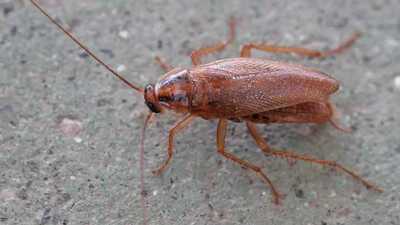
The German cockroach is the most common household roach worldwide. Adults are light caramel in colour with two distinct dark stripes running vertically behind their heads, and they grow to about the size of a penny. These cockroaches are fast movers and reproduce rapidly, females can produce hundreds of offspring in a year, with nymphs maturing in just over a month under ideal conditions.
German cockroaches prefer warm, humid environments such as kitchens, bathrooms, and laundry areas. They often arrive hidden in grocery bags or cardboard boxes. Because they spread easily and develop resistance to insecticides, infestations can become severe. If you spot them frequently, it’s best to seek professional pest control rather than relying on DIY treatments.
Brown-Banded Cockroach
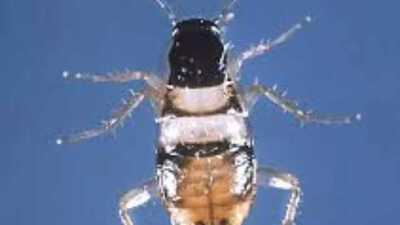
Smaller than the German variety, brown-banded cockroaches are light brown to golden in colour, with distinct bands across their wings and abdomen. Measuring about 1 to 1.5 centimetres long, males have wings and can fly, often appearing around lights at night.
These cockroaches prefer warmer temperatures above 26°C and are commonly found in apartments and heated buildings. Unlike other roaches that stay close to kitchens and drains, brown-banded cockroaches infest a variety of household spaces, behind paintings, inside furniture, and around electrical appliances. Because they scatter throughout the home, finding and treating their hiding spots requires careful inspection and consistent cleaning.
Oriental Cockroach
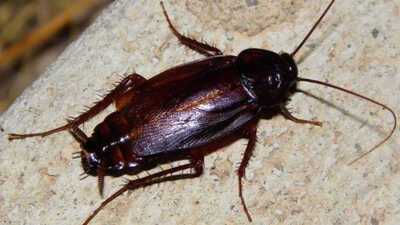
Often called “water bugs”, oriental cockroaches thrive in damp, dark areas such as basements, crawl spaces, drains, and garbage areas. Shiny and dark brown to black in colour, these slow-moving roaches grow up to 2.5 centimetres long and are often mistaken for beetles.
They prefer cooler environments and are most active at night. While they typically live outdoors, moisture problems indoors can draw them inside. Fixing leaks, improving ventilation, and keeping the area dry are key to preventing infestations.
American Cockroach
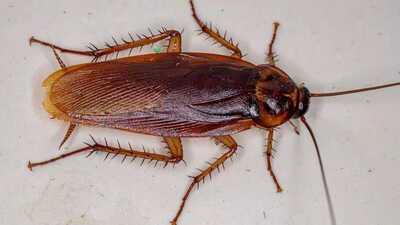
The American cockroach, sometimes referred to as the palmetto bug, is one of the largest species, reaching up to 4 centimetres in length. Reddish-brown with long antennae, these cockroaches thrive in warm, dark, and damp areas such as sewers, basements, and boiler rooms. They are also known to appear indoors after heavy rainfall when their outdoor habitats flood.
While not usually found in homes in large numbers, they can contaminate food and surfaces. Due to their attraction to decaying matter, they often carry harmful bacteria. Keeping drains clean and sealing entry points can help reduce their presence.
Smokybrown Cockroach
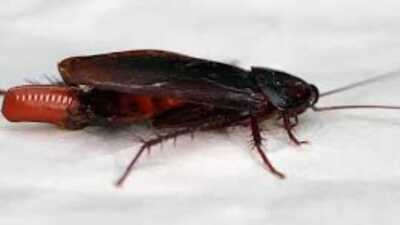
The smokybrown cockroach is another large species, deep reddish-brown and uniformly shiny in colour. Fully grown adults can measure up to 3.5 centimetres long. Common in the warm, humid climates of the southern United States, particularly Florida and Gulf states, they require constant moisture to survive.
These roaches are usually outdoor dwellers, nesting in mulch, trees, and gutters. However, they may wander indoors in search of food or water, especially if an attic or bathroom has moisture issues. Reducing humidity and trimming vegetation near windows can help keep them at bay.
Australian Cockroach
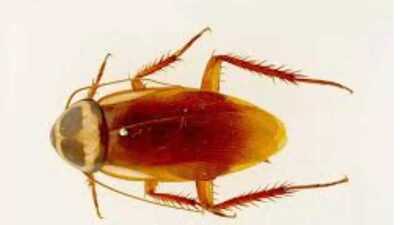
Native to tropical regions, the Australian cockroach looks similar to the American variety but is slightly smaller. It has light yellow markings on its head and along the edges of its wings. Preferring outdoor environments, it often enters homes through open doors or windows. Found mainly in coastal and southern states, these roaches are also common in greenhouses and humid structures. Though primarily outdoor pests, they can chew through fabrics, books, and even plants if they move inside, making early detection important.
Florida Woods Cockroach
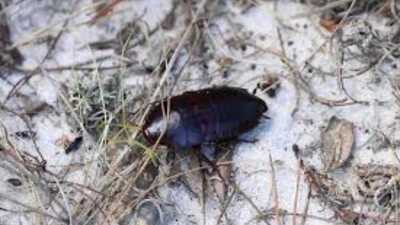
The Florida woods cockroach, also called the skunk roach, earns its nickname from the strong, foul-smelling fluid it releases when threatened. Large and shiny black, this species measures between 2.5 and 3.5 centimetres long.
These cockroaches thrive in warm, humid environments and are typically found in decaying wood, under leaves, or around tree trunks. They rarely infest homes but may wander indoors occasionally. Because they rely heavily on heat and humidity, they are mostly limited to southern climates.
Turkestan Cockroach
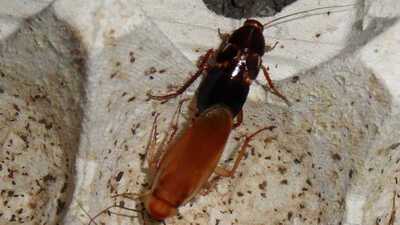
A relatively new species in the United States, the Turkestan cockroach is quickly spreading, particularly in western and southern states like Texas and California. Males are light tan with long wings, while females are darker and broader, often mistaken for oriental cockroaches. Both measure around 2.5 centimetres long.
These roaches are outdoor dwellers that thrive in compost piles, gardens, and leaf litter. They prefer dry climates but can enter buildings through gaps or vents. Reducing organic debris and sealing entry points are key to preventing infestations.
Identifying the specific cockroach species in your home can make all the difference in managing infestations effectively. While some types prefer outdoor habitats, others thrive indoors where warmth and moisture are abundant. Preventive measures such as sealing cracks, fixing leaks, keeping food covered, and maintaining cleanliness can go a long way in keeping roaches out for good.
Also Read: Keep your wardrobe bug-free with these 4 natural sweet-smelling naphthalene alternatives
8 common types of cockroaches and how to tell them apart
German Cockroach
The German cockroach is the most common household roach worldwide. Adults are light caramel in colour with two distinct dark stripes running vertically behind their heads, and they grow to about the size of a penny. These cockroaches are fast movers and reproduce rapidly, females can produce hundreds of offspring in a year, with nymphs maturing in just over a month under ideal conditions.
German cockroaches prefer warm, humid environments such as kitchens, bathrooms, and laundry areas. They often arrive hidden in grocery bags or cardboard boxes. Because they spread easily and develop resistance to insecticides, infestations can become severe. If you spot them frequently, it’s best to seek professional pest control rather than relying on DIY treatments.
Brown-Banded Cockroach

Smaller than the German variety, brown-banded cockroaches are light brown to golden in colour, with distinct bands across their wings and abdomen. Measuring about 1 to 1.5 centimetres long, males have wings and can fly, often appearing around lights at night.
These cockroaches prefer warmer temperatures above 26°C and are commonly found in apartments and heated buildings. Unlike other roaches that stay close to kitchens and drains, brown-banded cockroaches infest a variety of household spaces, behind paintings, inside furniture, and around electrical appliances. Because they scatter throughout the home, finding and treating their hiding spots requires careful inspection and consistent cleaning.
Oriental Cockroach
Often called “water bugs”, oriental cockroaches thrive in damp, dark areas such as basements, crawl spaces, drains, and garbage areas. Shiny and dark brown to black in colour, these slow-moving roaches grow up to 2.5 centimetres long and are often mistaken for beetles.
They prefer cooler environments and are most active at night. While they typically live outdoors, moisture problems indoors can draw them inside. Fixing leaks, improving ventilation, and keeping the area dry are key to preventing infestations.
American Cockroach

The American cockroach, sometimes referred to as the palmetto bug, is one of the largest species, reaching up to 4 centimetres in length. Reddish-brown with long antennae, these cockroaches thrive in warm, dark, and damp areas such as sewers, basements, and boiler rooms. They are also known to appear indoors after heavy rainfall when their outdoor habitats flood.
While not usually found in homes in large numbers, they can contaminate food and surfaces. Due to their attraction to decaying matter, they often carry harmful bacteria. Keeping drains clean and sealing entry points can help reduce their presence.
Smokybrown Cockroach
The smokybrown cockroach is another large species, deep reddish-brown and uniformly shiny in colour. Fully grown adults can measure up to 3.5 centimetres long. Common in the warm, humid climates of the southern United States, particularly Florida and Gulf states, they require constant moisture to survive.
These roaches are usually outdoor dwellers, nesting in mulch, trees, and gutters. However, they may wander indoors in search of food or water, especially if an attic or bathroom has moisture issues. Reducing humidity and trimming vegetation near windows can help keep them at bay.
Australian Cockroach
Native to tropical regions, the Australian cockroach looks similar to the American variety but is slightly smaller. It has light yellow markings on its head and along the edges of its wings. Preferring outdoor environments, it often enters homes through open doors or windows. Found mainly in coastal and southern states, these roaches are also common in greenhouses and humid structures. Though primarily outdoor pests, they can chew through fabrics, books, and even plants if they move inside, making early detection important.
Florida Woods Cockroach
The Florida woods cockroach, also called the skunk roach, earns its nickname from the strong, foul-smelling fluid it releases when threatened. Large and shiny black, this species measures between 2.5 and 3.5 centimetres long.
These cockroaches thrive in warm, humid environments and are typically found in decaying wood, under leaves, or around tree trunks. They rarely infest homes but may wander indoors occasionally. Because they rely heavily on heat and humidity, they are mostly limited to southern climates.
Turkestan Cockroach
A relatively new species in the United States, the Turkestan cockroach is quickly spreading, particularly in western and southern states like Texas and California. Males are light tan with long wings, while females are darker and broader, often mistaken for oriental cockroaches. Both measure around 2.5 centimetres long.
These roaches are outdoor dwellers that thrive in compost piles, gardens, and leaf litter. They prefer dry climates but can enter buildings through gaps or vents. Reducing organic debris and sealing entry points are key to preventing infestations.
Identifying the specific cockroach species in your home can make all the difference in managing infestations effectively. While some types prefer outdoor habitats, others thrive indoors where warmth and moisture are abundant. Preventive measures such as sealing cracks, fixing leaks, keeping food covered, and maintaining cleanliness can go a long way in keeping roaches out for good.
Also Read: Keep your wardrobe bug-free with these 4 natural sweet-smelling naphthalene alternatives
You may also like

Who is Brandon Miller's mother? The fearless woman who beat cancer and built her son's fighting spirit

High street giant gives out £10 mystery bundles as it closes 145 stores for good

Andrew suffers blistering new humiliation as poll shows where public stands on King's move

Covid inquiry is a great betrayal of our children and tragically wasted opportunity

260,000 GPUs to be deployed to build AI factories in S. Korea





